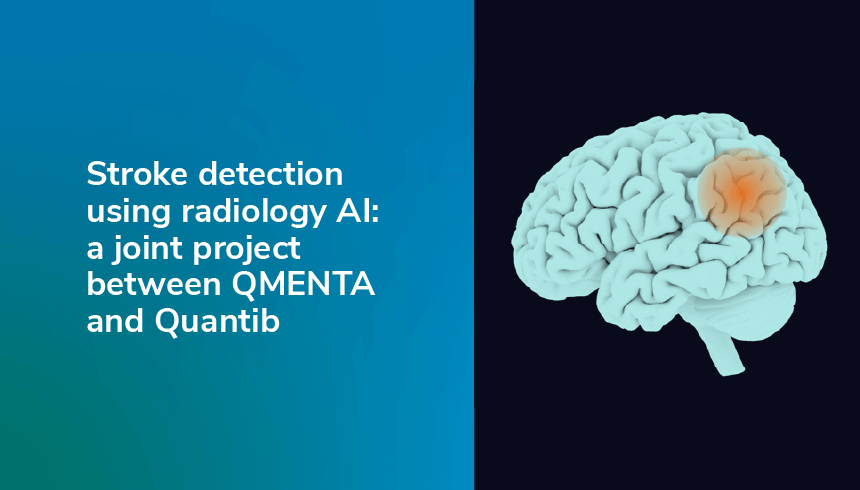Stroke diagnosis and artificial intelligence
The treatment for different types of stroke differs strongly. Ischemic stroke is regularly treated by administering tPA within preferably 3 hours after stroke onset, where hemorrhagic stroke requires e.g. the insertion of a coil and may require surgical intervention. It is crucial to get the diagnosis right, as administering tPA to a patient suffering from hemorrhagic stroke comes with a chance of high damage, possibly even leading to death.(4–6) However, getting to a correct imaging based diagnosis as soon as possible can be challenging. Therefore, the analysis of early stroke imaging is an interesting case to utilize advanced image processing algorithms. Artificial intelligence can distinguish one type of stroke from another by detecting the smallest deviations only shortly after stroke onset.
Quantib + QMENTA = an efficient road to stroke diagnosis support
Under the Eurostar grant Quantib and QMENTA started the CASE project last year. This two-year project requires niche expertise on neuro-image analysis algorithms and neuroscience platform development, making Quantib and QMENTA the ideal combination to tackle this project. Their joined forces will enable a faster route-to-market getting the solution to the hospitals faster where it can contribute to saving patients’ lives.
QMENTA has previously designed a state-of-the-art cloud-based platform to support neuroscience R&D with its advanced data management, image processing, and visualization capabilities. Hence, they have the right expertise and the ideal medium for collaborative projects. Its infrastructure enables secure data sharing combined with the possibility to plug-in external algorithms which can be used via an easily-accessible and user-friendly platform.
Quantib is an industry leader in the development of radiology artificial intelligence. Their expertise in the realm of machine learning neurology applications and vast experience puts Quantib in the best position to design and implement the stroke diagnosis support algorithm required for CASE.
The goal: a clinical decision support tool for stroke
The project consists of four stages, where the first stage of image collection and annotation is currently being wrapped up. The second stage will consist of algorithm development and validation done by Quantib. A fully-automated segmentation algorithm and atlas-based labelling of the CT dataset will enable us to implement clinically accepted semi-quantitative scores used in clinical decision making, such as ASPECT.
In the third stage the focus will be on integrating the image analysis algorithms of Quantib into the QMENTA cloud platform, which will be done in close collaboration with physicians. Simultaneously, a continuous data integration infrastructure will be developed on the cloud. This will enable new data to be constantly added, rendering the system ready for ongoing machine and deep learning. The last stage will be a refinement step by applying machine and deep learning techniques to improve the existing models.
The end product will be a CE-marked and clinically validated decision-support tool. It will automatically identify ischemic or hemorrhagic stroke on a non-contrast CT scan. Also, in case of a follow-up scan, the change in volume over time of e.g. intraventricular blood or cerebral edema will be determined. All functions created by Quantib will be integrated with QMENTA’s cloud-based platform to maximize easy access, allow ability to combine with clinical scorings, and provide visualization.
Interested in learning more about the CASE project? Or do you have feedback or suggestions for improvements? Check out our CASE webpage, or follow QMENTA and Quantib on Twitter to keep up with the latest developments and results.
References
- Benjamin, E. J. et al. Heart Disease and Stroke Statistics-2017 Update: A Report From the American Heart Association. Circulation 135, e146–e603 (2017).
- SAFE. Available at: http://www.safestroke.eu/facts-figures/. (Accessed: 11th May 2018)
- Stevens, E., Emmett, E., Yanzhong, W., McKevvit, C. & Wolfe, C. The burden of stroke.
- Types of stroke, stroke association. (2018). Available at: http://www.strokeassociation.org/STROKEORG/AboutStroke/TypesofStroke/Types-of-Stroke_UCM_308531_SubHomePage.jsp. (Accessed: 5th November 2018)
- Andre, D. Ischemic vs Hemorrhagic Stroke: Causes, Symptoms, Treatment, and Prognosis. (2018). Available at: https://www.belmarrahealth.com/ischemic-vs-hemorrhagic-stroke-causes-symptoms-treatment-prognosis/.
- American Stroke Association. Stroke treatments. (2013). Available at: www.strokeassociation.org/STROKEORG/AboutStroke/BLS/Stroke-Treatments_UCM_310892_Article.jsp#.WnxNJqjiYuU.

